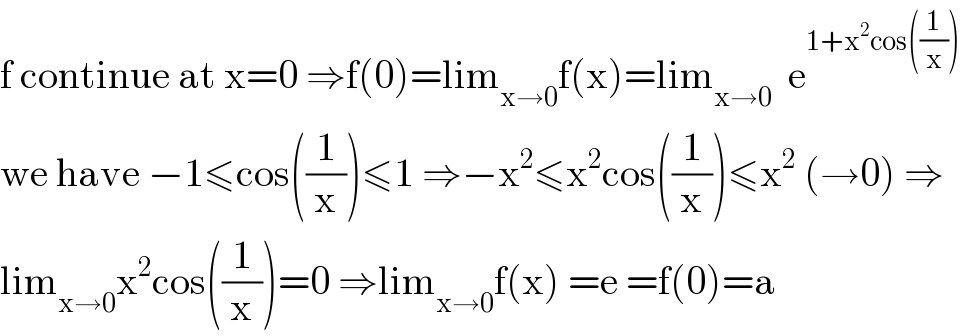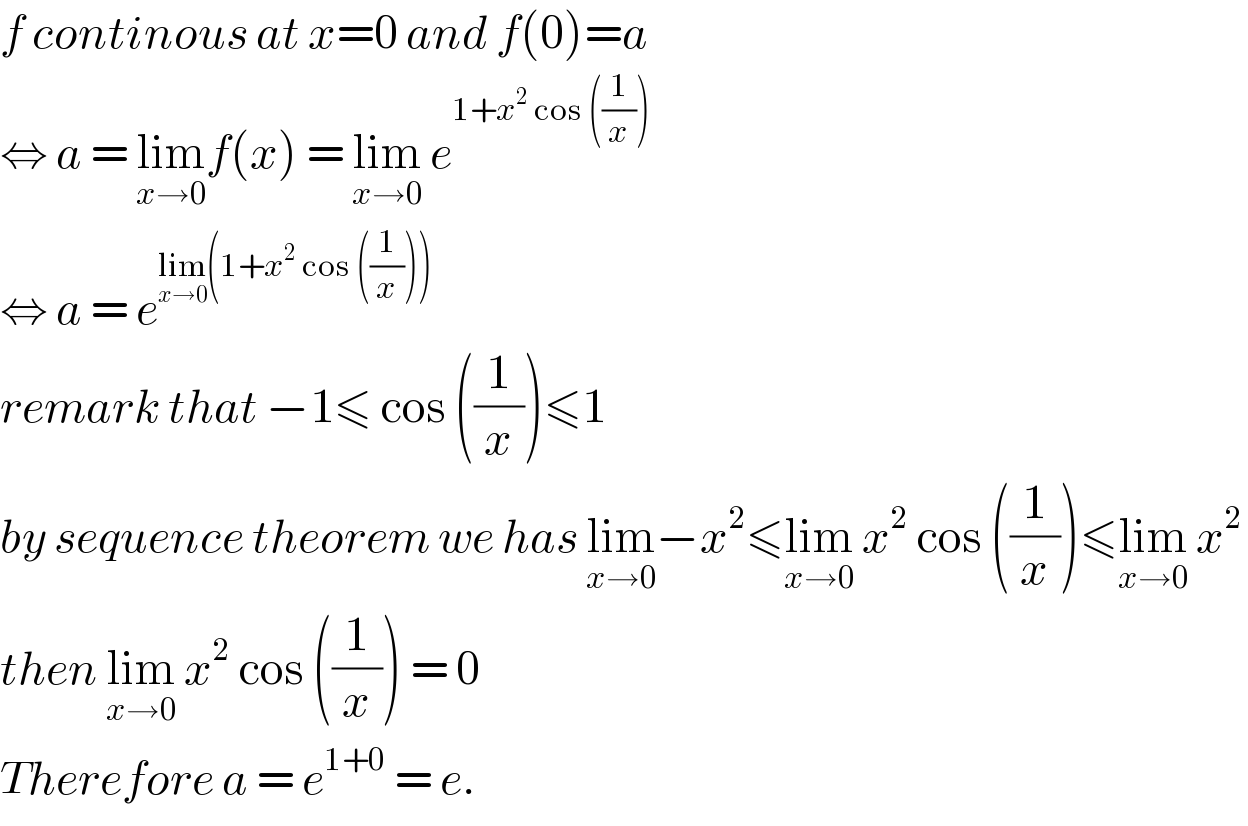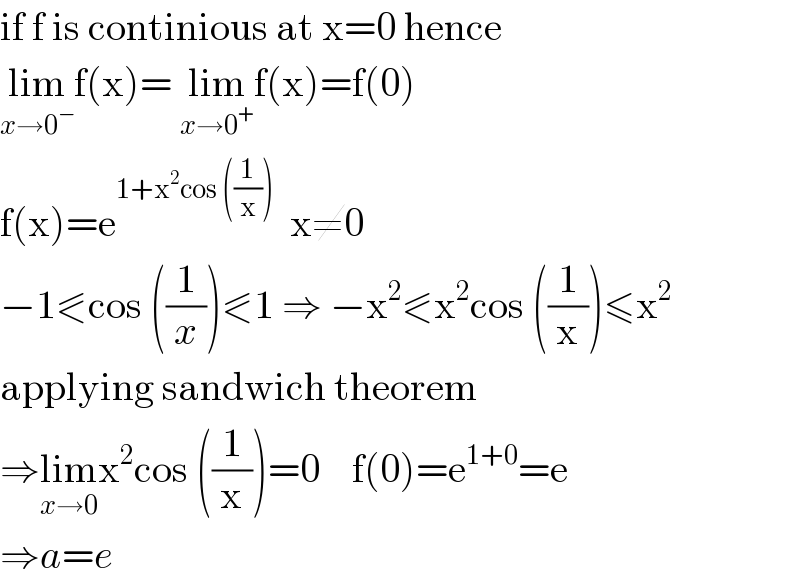
Question Number 120268 by bramlexs22 last updated on 30/Oct/20

Answered by mathmax by abdo last updated on 30/Oct/20

$$\mathrm{f}\:\mathrm{continue}\:\mathrm{at}\:\mathrm{x}=\mathrm{0}\:\Rightarrow\mathrm{f}\left(\mathrm{0}\right)=\mathrm{lim}_{\mathrm{x}\rightarrow\mathrm{0}} \mathrm{f}\left(\mathrm{x}\right)=\mathrm{lim}_{\mathrm{x}\rightarrow\mathrm{0}} \:\:\mathrm{e}^{\mathrm{1}+\mathrm{x}^{\mathrm{2}} \mathrm{cos}\left(\frac{\mathrm{1}}{\mathrm{x}}\right)} \\ $$$$\mathrm{we}\:\mathrm{have}\:−\mathrm{1}\leqslant\mathrm{cos}\left(\frac{\mathrm{1}}{\mathrm{x}}\right)\leqslant\mathrm{1}\:\Rightarrow−\mathrm{x}^{\mathrm{2}} \leqslant\mathrm{x}^{\mathrm{2}} \mathrm{cos}\left(\frac{\mathrm{1}}{\mathrm{x}}\right)\leqslant\mathrm{x}^{\mathrm{2}} \:\left(\rightarrow\mathrm{0}\right)\:\Rightarrow \\ $$$$\mathrm{lim}_{\mathrm{x}\rightarrow\mathrm{0}} \mathrm{x}^{\mathrm{2}} \mathrm{cos}\left(\frac{\mathrm{1}}{\mathrm{x}}\right)=\mathrm{0}\:\Rightarrow\mathrm{lim}_{\mathrm{x}\rightarrow\mathrm{0}} \mathrm{f}\left(\mathrm{x}\right)\:=\mathrm{e}\:=\mathrm{f}\left(\mathrm{0}\right)=\mathrm{a} \\ $$
Answered by bemath last updated on 30/Oct/20

$${f}\:{continous}\:{at}\:{x}=\mathrm{0}\:{and}\:{f}\left(\mathrm{0}\right)={a} \\ $$$$\Leftrightarrow\:{a}\:=\:\underset{{x}\rightarrow\mathrm{0}} {\mathrm{lim}}{f}\left({x}\right)\:=\:\underset{{x}\rightarrow\mathrm{0}} {\mathrm{lim}}\:{e}^{\mathrm{1}+{x}^{\mathrm{2}} \:\mathrm{cos}\:\left(\frac{\mathrm{1}}{{x}}\right)} \\ $$$$\Leftrightarrow\:{a}\:=\:{e}^{\underset{{x}\rightarrow\mathrm{0}} {\mathrm{lim}}\left(\mathrm{1}+{x}^{\mathrm{2}} \:\mathrm{cos}\:\left(\frac{\mathrm{1}}{{x}}\right)\right)} \\ $$$${remark}\:{that}\:−\mathrm{1}\leqslant\:\mathrm{cos}\:\left(\frac{\mathrm{1}}{{x}}\right)\leqslant\mathrm{1} \\ $$$${by}\:{sequence}\:{theorem}\:{we}\:{has}\:\underset{{x}\rightarrow\mathrm{0}} {\mathrm{lim}}−{x}^{\mathrm{2}} \leqslant\underset{{x}\rightarrow\mathrm{0}} {\mathrm{lim}}\:{x}^{\mathrm{2}} \:\mathrm{cos}\:\left(\frac{\mathrm{1}}{{x}}\right)\leqslant\underset{{x}\rightarrow\mathrm{0}} {\mathrm{lim}}\:{x}^{\mathrm{2}} \\ $$$${then}\:\underset{{x}\rightarrow\mathrm{0}} {\mathrm{lim}}\:{x}^{\mathrm{2}} \:\mathrm{cos}\:\left(\frac{\mathrm{1}}{{x}}\right)\:=\:\mathrm{0} \\ $$$${Therefore}\:{a}\:=\:{e}^{\mathrm{1}+\mathrm{0}} \:=\:{e}.\: \\ $$
Answered by TITA last updated on 30/Oct/20

$$\mathrm{if}\:\mathrm{f}\:\mathrm{is}\:\mathrm{continious}\:\mathrm{at}\:\mathrm{x}=\mathrm{0}\:\mathrm{hence} \\ $$$$\underset{{x}\rightarrow\mathrm{0}^{−} } {\mathrm{lim}f}\left(\mathrm{x}\right)=\:\underset{{x}\rightarrow\mathrm{0}^{+} } {\mathrm{lim}f}\left(\mathrm{x}\right)=\mathrm{f}\left(\mathrm{0}\right) \\ $$$$\mathrm{f}\left(\mathrm{x}\right)=\mathrm{e}^{\mathrm{1}+\mathrm{x}^{\mathrm{2}} \mathrm{cos}\:\left(\frac{\mathrm{1}}{\mathrm{x}}\right)} \:\:\mathrm{x}\neq\mathrm{0}\:\:\:\:\: \\ $$$$−\mathrm{1}\eqslantless\mathrm{cos}\:\left(\frac{\mathrm{1}}{{x}}\right)\eqslantless\mathrm{1}\:\Rightarrow\:−\mathrm{x}^{\mathrm{2}} \eqslantless\mathrm{x}^{\mathrm{2}} \mathrm{cos}\:\left(\frac{\mathrm{1}}{\mathrm{x}}\right)\leqslant\mathrm{x}^{\mathrm{2}} \\ $$$$\mathrm{applying}\:\mathrm{sandwich}\:\mathrm{theorem}\: \\ $$$$\Rightarrow\underset{{x}\rightarrow\mathrm{0}} {\mathrm{lim}x}^{\mathrm{2}} \mathrm{cos}\:\left(\frac{\mathrm{1}}{\mathrm{x}}\right)=\mathrm{0}\:\:\:\:\mathrm{f}\left(\mathrm{0}\right)=\mathrm{e}^{\mathrm{1}+\mathrm{0}} =\mathrm{e}\: \\ $$$$\Rightarrow{a}={e} \\ $$
Commented by bemath last updated on 30/Oct/20

$${what}\:{it}\:{sandwich}\:{theorem}? \\ $$
Commented by mathmax by abdo last updated on 08/Nov/20

$$\mathrm{this}\:\mathrm{sandwich}\:\mathrm{is}\:\mathrm{good}.... \\ $$
